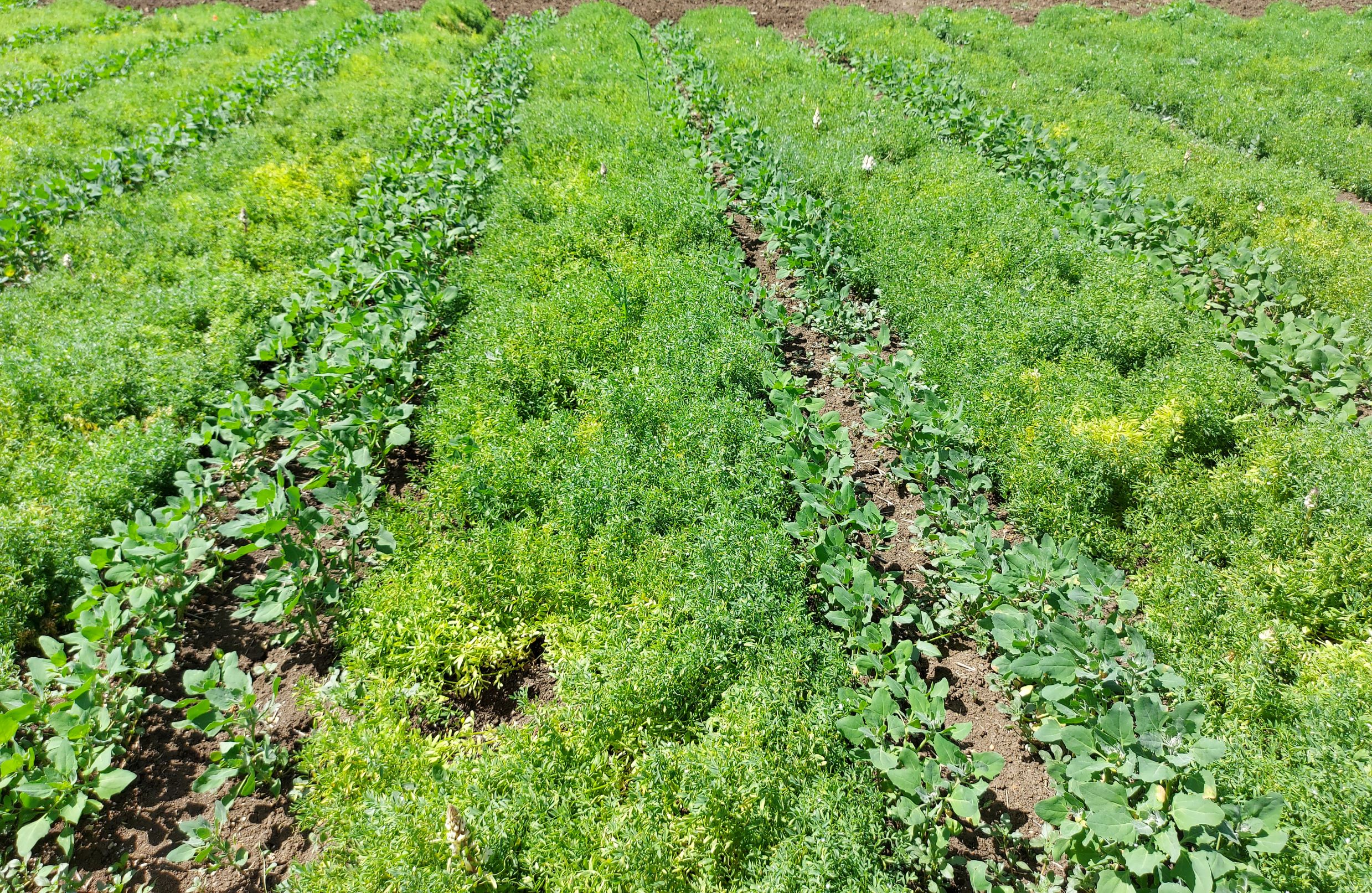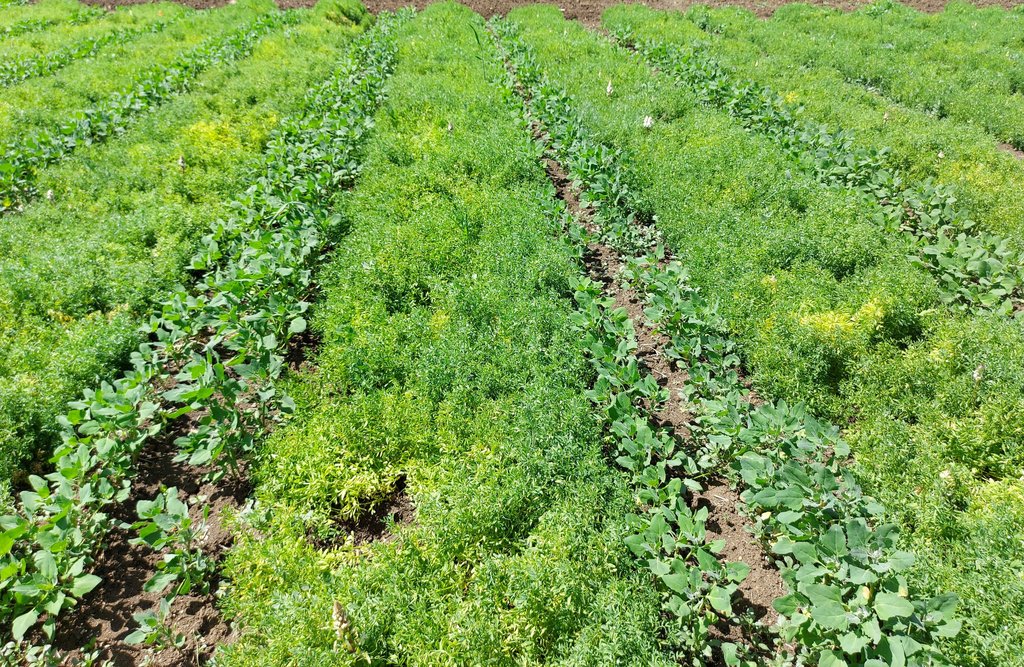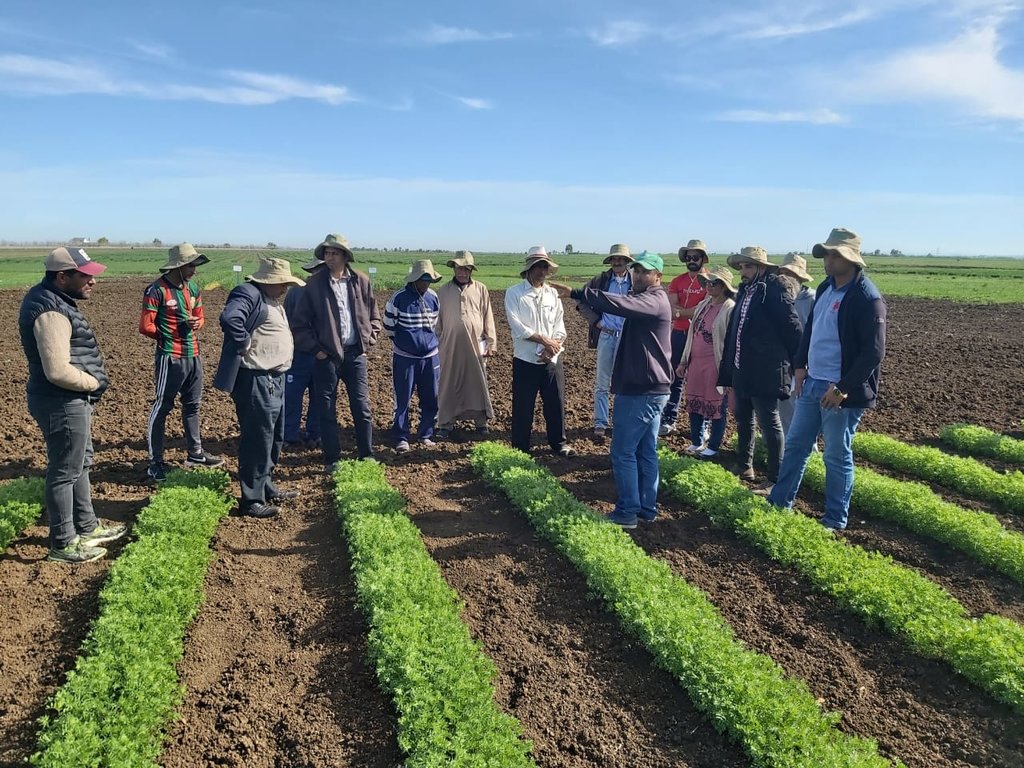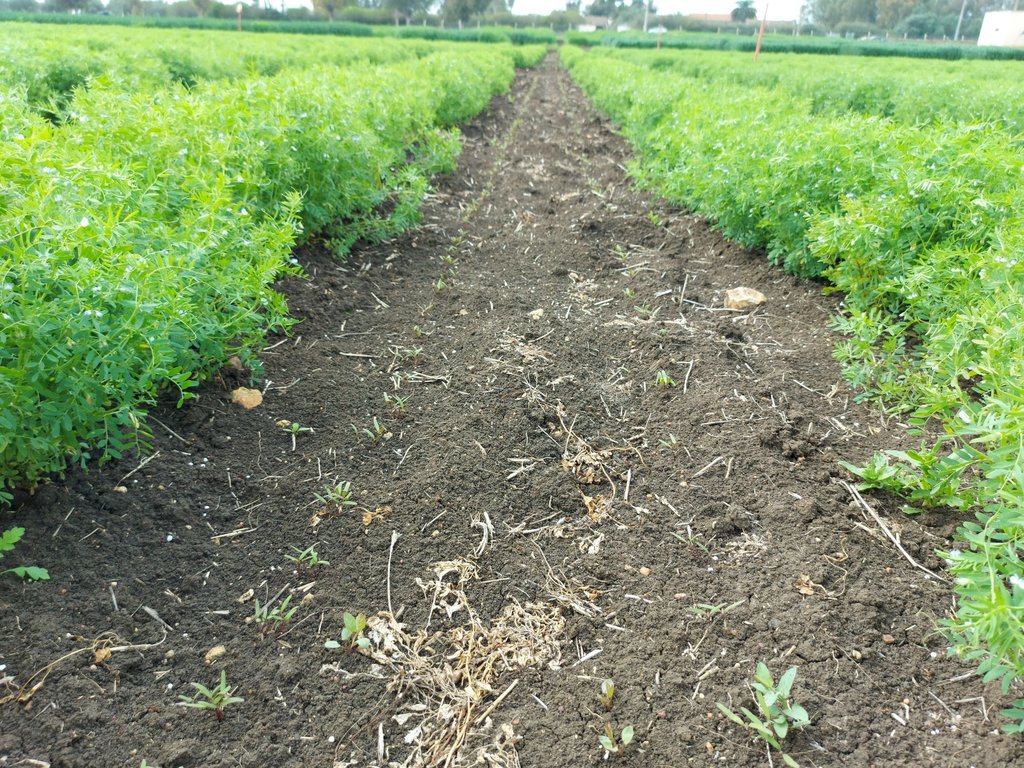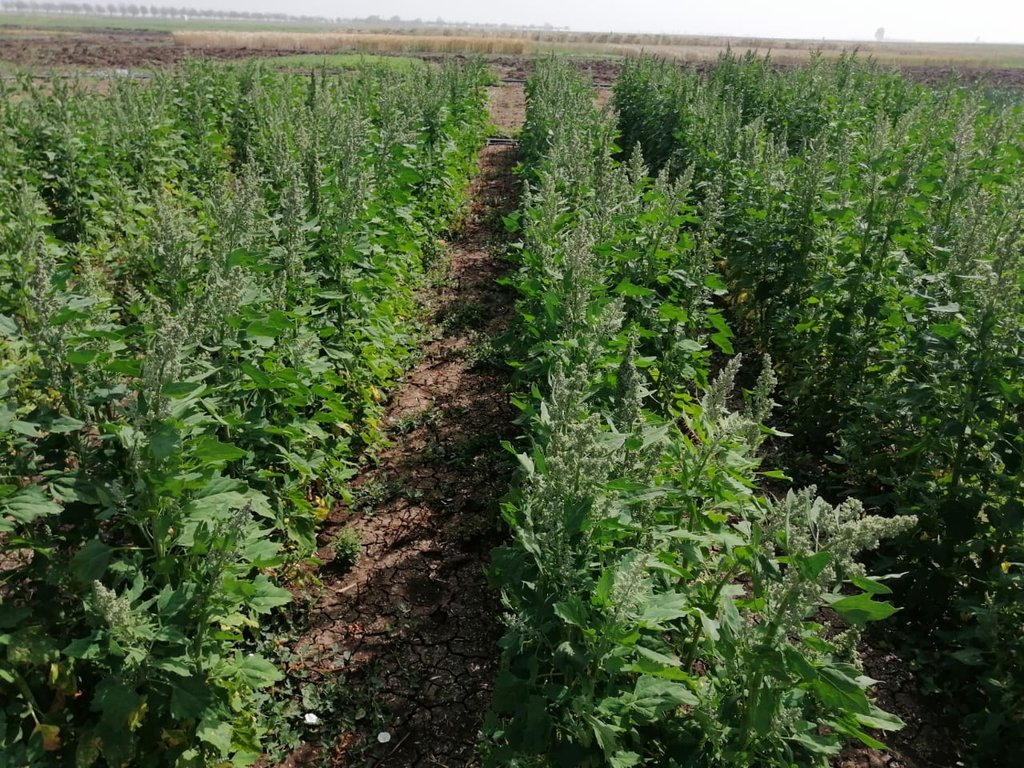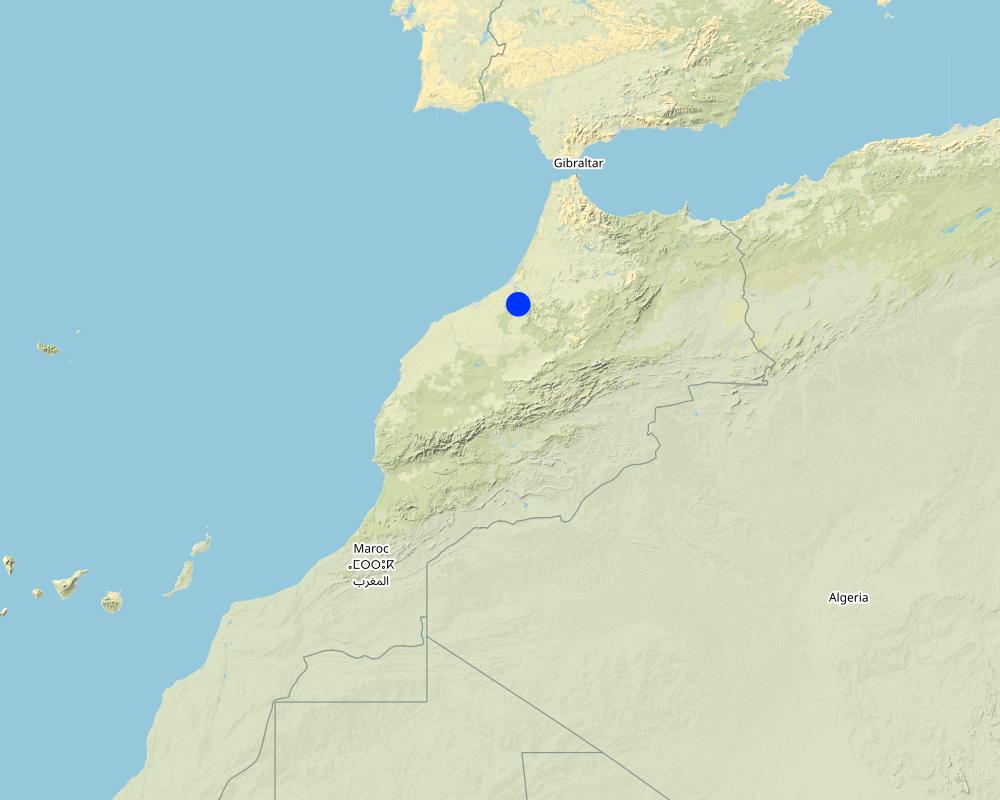Diversified Cropping System: Relay Intercropping of Lentil with Quinoa [Morocco]
- Creation:
- Update:
- Compiler: Joren Verbist
- Editor: –
- Reviewers: William Critchley, Rima Mekdaschi Studer
technologies_5967 - Morocco
View sections
Expand all Collapse all1. General information
1.2 Contact details of resource persons and institutions involved in the assessment and documentation of the Technology
Key resource person(s)
Agronomist:
Devkota Mina
International Center of Agriculture Research in the Dry Areas (ICARDA)
Morocco
Research Team Leader - Soils, Waters and Agronomy:
Nangia Vinay
International Center of Agriculture Research in the Dry Areas (ICARDA)
Morocco
Name of project which facilitated the documentation/ evaluation of the Technology (if relevant)
ICARDA Institutional Knowledge Management InitiativeName of the institution(s) which facilitated the documentation/ evaluation of the Technology (if relevant)
International Center for Agricultural Research in the Dry Areas (ICARDA) - Lebanon1.3 Conditions regarding the use of data documented through WOCAT
The compiler and key resource person(s) accept the conditions regarding the use of data documented through WOCAT:
Yes
1.4 Declaration on sustainability of the described Technology
Is the Technology described here problematic with regard to land degradation, so that it cannot be declared a sustainable land management technology?
No
2. Description of the SLM Technology
2.1 Short description of the Technology
Definition of the Technology:
A Diversified Cropping System (DCS) results in a more resilient and intensive cropping system. In this case quinoa was introduced as an intercrop for lentil. The yield of lentil is not reduced; hence the system becomes more productive, profitable and resilient with the introduction of quinoa.
2.2 Detailed description of the Technology
Description:
In the semi-arid regions of Morocco agricultural production is unstable, and yields are declining as consequence of climate change. Climate change leads to more irregular rainfall and more frequent extreme weather events. There is a need, where possible, to intensify agricultural systems while improving food security - through increasing the resilience of the overall system.
Cultivating lentils is common practice in rural Morocco. To intensify this cropping system, taking into account the effects of climate change, the International Centre for Agricultural Research Dry Areas (ICARDA) introduced quinoa into the common lentil production system. Importantly, quinoa does not affect the yields of lentil because it does not significantly compete for water and nutrients. With two crops harvested from the same piece of land, overall farm profit increases. Furthermore, the cultivation of two crops creates a more resilient overall system because the farmer is not dependent on one single crop. Additionally, as quinoa is harvested later than lentil, the soil is covered for a longer period, consequently protecting it from degradation, hence soil quality is improved. In addition, lentils are leguminous, fixing nitrogen in the soil, thus improving soil conditions for growth.
However the technology has some potential drawbacks. Firstly, in Morocco, the market for quinoa is not well developed, hence achieving a good market price could be problematic if planted at scale. Secondly, in years of extreme droughts, quinoa requires supplementary irrigation, especially during crop establishment. This is often inaccessible, resulting in poor crop establishment and low yield. Thirdly, if planted in small plots there may be risks of free grazing livestock as well as pest and insect infestations. This can be overcome by community farming and pest control.
In 2020 and 2021, ICARDA tested this Diversified Cropping System on a trial field of half a hectare, in an area with average annual precipitation of 400 mm. DCS is implemented in the following order of activities. The field is prepared by ploughing. In December, lentils are mechanically seeded. Two rows of lentils are planted 15 cm apart. The spacing between each two-row pair is roughly 90 cm. Compound fertilizer is applied during the seeding. In January, a herbicide is sprayed to control grassy weeds. The field is mechanically weeded twice, in mid-January and then again in February.
The quinoa is then seeded at the end of February: also in paired lines (two rows at 20 cm apart) and also with compound fertilizer. Each pair of quinoa lines is planted between pairs of lentils. Because the quinoa is planted within an already growing crop of lentils, this form of intercropping is termed "relay planting".
The quinoa is manually weeded in March. In April, the lentils are manually harvested and mechanically threshed. A single spray of insecticide is applied in April-May. Finally, in June, the quinoa is mechanically harvested.
This documentation illustrated an ICARDA innovation which is accessible since there are no establishment events and costs. This Diversified Cropping System improves a traditional system by introducing an additional crop, resulting in better farm income and more resilience.
2.3 Photos of the Technology
2.5 Country/ region/ locations where the Technology has been applied and which are covered by this assessment
Country:
Morocco
Further specification of location:
Merchouch
Specify the spread of the Technology:
- evenly spread over an area
If precise area is not known, indicate approximate area covered:
- < 0.1 km2 (10 ha)
Is/are the technology site(s) located in a permanently protected area?
No
Map
×2.6 Date of implementation
Indicate year of implementation:
2020
2.7 Introduction of the Technology
Specify how the Technology was introduced:
- during experiments/ research
- through projects/ external interventions
3. Classification of the SLM Technology
3.1 Main purpose(s) of the Technology
- improve production
- adapt to climate change/ extremes and its impacts
- create beneficial economic impact
3.2 Current land use type(s) where the Technology is applied

Cropland
- Annual cropping
Annual cropping - Specify crops:
- cereals - quinoa or amaranth
- legumes and pulses - lentils
Number of growing seasons per year:
- 1
Is intercropping practiced?
Yes
If yes, specify which crops are intercropped:
Quinoa is intercropped with Lentils
3.3 Has land use changed due to the implementation of the Technology?
Has land use changed due to the implementation of the Technology?
- No (Continue with question 3.4)
3.4 Water supply
Water supply for the land on which the Technology is applied:
- rainfed
3.5 SLM group to which the Technology belongs
- improved ground/ vegetation cover
3.6 SLM measures comprising the Technology

agronomic measures
- A1: Vegetation/ soil cover

vegetative measures

management measures
- M2: Change of management/ intensity level
- M4: Major change in timing of activities
3.7 Main types of land degradation addressed by the Technology

soil erosion by water
- Wt: loss of topsoil/ surface erosion

soil erosion by wind
- Et: loss of topsoil
3.8 Prevention, reduction, or restoration of land degradation
Specify the goal of the Technology with regard to land degradation:
- reduce land degradation
4. Technical specifications, implementation activities, inputs, and costs
4.1 Technical drawing of the Technology
Technical specifications (related to technical drawing):
The technical drawing relates to the following quantification:
A: Spacing between a row of lentil and a row of quinoa = 35 centimetres
B: Spacing between two rows of lentil in the same pair = 15 centimetres
C: Spacing between two rows of quinoa in the same pair = 20 centimetres
D: Spacing between two rows of lentil bordering a pair of quinoa = 90 - 95 centimetres
In a row, the plants are planted continuously.
Author:
Joren Verbist
Date:
01/09/2021
4.2 General information regarding the calculation of inputs and costs
Specify how costs and inputs were calculated:
- per Technology area
Indicate size and area unit:
1 Hectare
other/ national currency (specify):
Moroccan Dihram (MAD)
If relevant, indicate exchange rate from USD to local currency (e.g. 1 USD = 79.9 Brazilian Real): 1 USD =:
9.0
Indicate average wage cost of hired labour per day:
75
4.5 Maintenance/ recurrent activities
| Activity | Timing/ frequency | |
|---|---|---|
| 1. | Field Ploughing | Prior of Seeding |
| 2. | Lentil Seeding | December |
| 3. | Fertilizer Application (Lentil) | During Seeding |
| 4. | Herbicide Application (Lentil) | January |
| 5. | Mechanical Weeding (Lentil) | Mid January |
| 6. | Second Mechanical Weeding (Lentil) | Mid February |
| 7. | Fungicide Application (Lentil) | February-March |
| 8. | Quinoa Seeding | End of February |
| 9. | Fertilizer Application (Quinoa) | During Seeding |
| 10. | Lentil Harvesting | April |
| 11. | Manual Weeding (Quinoa) | March |
| 12. | Insecticide Application (Quinoa) | April-May |
| 13. | Harvesting Quinoa | June |
4.6 Costs and inputs needed for maintenance/ recurrent activities (per year)
| Specify input | Unit | Quantity | Costs per Unit | Total costs per input | % of costs borne by land users | |
|---|---|---|---|---|---|---|
| Labour | Lentil Harvesting | Person-Days | 10.0 | 75.0 | 750.0 | 100.0 |
| Labour | Weeding (lentil) | Person-Days | 10.0 | 75.0 | 750.0 | 100.0 |
| Labour | Weeding (quinoa) | Person-Days | 20.0 | 75.0 | 1500.0 | 100.0 |
| Equipment | Lentil Thresher | Machine-Hours | 2.0 | 150.0 | 300.0 | 100.0 |
| Equipment | Quinoa Harvester | Machine-Hours | 1.0 | 500.0 | 500.0 | 100.0 |
| Equipment | Lentil Seeder | Machine-Hours | 1.0 | 150.0 | 150.0 | 100.0 |
| Equipment | Quinoa Seeder | Machine-Hours | 1.0 | 150.0 | 150.0 | 100.0 |
| Equipment | Sprayer | Machine-Hours | 3.0 | 60.0 | 180.0 | 100.0 |
| Equipment | Weeder | Machine-Hours | 2.0 | 100.0 | 200.0 | 100.0 |
| Plant material | Lentil Seeds | Kilogram | 45.0 | 8.0 | 360.0 | 100.0 |
| Plant material | Quinoa Seeds | Kilogram | 3.5 | 40.0 | 140.0 | 100.0 |
| Fertilizers and biocides | NPK 10-20-20 (for Lentil) | Kilogram | 100.0 | 3.0 | 300.0 | 100.0 |
| Fertilizers and biocides | NPK 15-15-15 (for Quinoa) | Kilogram | 150.0 | 3.0 | 450.0 | 100.0 |
| Fertilizers and biocides | Herbicide (for Lentil) | Liter | 1.0 | 170.0 | 170.0 | 100.0 |
| Fertilizers and biocides | Insecticide (for Quinoa) | Milliliter | 50.0 | 1.5 | 75.0 | 100.0 |
| Fertilizers and biocides | Fungicide (for Lentil) | Liter | 0.5 | 150.0 | 75.0 | 100.0 |
| Total costs for maintenance of the Technology | 6050.0 | |||||
| Total costs for maintenance of the Technology in USD | 672.22 | |||||
5. Natural and human environment
5.1 Climate
Annual rainfall
- < 250 mm
- 251-500 mm
- 501-750 mm
- 751-1,000 mm
- 1,001-1,500 mm
- 1,501-2,000 mm
- 2,001-3,000 mm
- 3,001-4,000 mm
- > 4,000 mm
Specify average annual rainfall (if known), in mm:
400.00
Agro-climatic zone
- semi-arid
5.2 Topography
Slopes on average:
- flat (0-2%)
- gentle (3-5%)
- moderate (6-10%)
- rolling (11-15%)
- hilly (16-30%)
- steep (31-60%)
- very steep (>60%)
Landforms:
- plateau/plains
- ridges
- mountain slopes
- hill slopes
- footslopes
- valley floors
Altitudinal zone:
- 0-100 m a.s.l.
- 101-500 m a.s.l.
- 501-1,000 m a.s.l.
- 1,001-1,500 m a.s.l.
- 1,501-2,000 m a.s.l.
- 2,001-2,500 m a.s.l.
- 2,501-3,000 m a.s.l.
- 3,001-4,000 m a.s.l.
- > 4,000 m a.s.l.
Indicate if the Technology is specifically applied in:
- not relevant
5.3 Soils
Soil depth on average:
- very shallow (0-20 cm)
- shallow (21-50 cm)
- moderately deep (51-80 cm)
- deep (81-120 cm)
- very deep (> 120 cm)
Soil texture (topsoil):
- medium (loamy, silty)
Soil texture (> 20 cm below surface):
- medium (loamy, silty)
Topsoil organic matter:
- medium (1-3%)
5.4 Water availability and quality
Ground water table:
5-50 m
Availability of surface water:
poor/ none
Water quality (untreated):
poor drinking water (treatment required)
Water quality refers to:
ground water
Is water salinity a problem?
No
Is flooding of the area occurring?
No
5.5 Biodiversity
Species diversity:
- low
Habitat diversity:
- low
5.6 Characteristics of land users applying the Technology
Sedentary or nomadic:
- Sedentary
Market orientation of production system:
- mixed (subsistence/ commercial)
Off-farm income:
- less than 10% of all income
Relative level of wealth:
- poor
Individuals or groups:
- individual/ household
Level of mechanization:
- mechanized/ motorized
Gender:
- women
- men
Age of land users:
- middle-aged
5.7 Average area of land used by land users applying the Technology
- < 0.5 ha
- 0.5-1 ha
- 1-2 ha
- 2-5 ha
- 5-15 ha
- 15-50 ha
- 50-100 ha
- 100-500 ha
- 500-1,000 ha
- 1,000-10,000 ha
- > 10,000 ha
Is this considered small-, medium- or large-scale (referring to local context)?
- small-scale
- medium-scale
5.8 Land ownership, land use rights, and water use rights
Land ownership:
- individual, not titled
- individual, titled
Land use rights:
- individual
Water use rights:
- individual
Are land use rights based on a traditional legal system?
Yes
5.9 Access to services and infrastructure
health:
- poor
- moderate
- good
education:
- poor
- moderate
- good
technical assistance:
- poor
- moderate
- good
employment (e.g. off-farm):
- poor
- moderate
- good
markets:
- poor
- moderate
- good
energy:
- poor
- moderate
- good
roads and transport:
- poor
- moderate
- good
drinking water and sanitation:
- poor
- moderate
- good
financial services:
- poor
- moderate
- good
6. Impacts and concluding statements
6.1 On-site impacts the Technology has shown
Socio-economic impacts
Production
crop production
crop quality
risk of production failure
product diversity
production area
land management
Income and costs
expenses on agricultural inputs
farm income
workload
Socio-cultural impacts
food security/ self-sufficiency
SLM/ land degradation knowledge
Ecological impacts
Soil
soil moisture
soil cover
soil loss
nutrient cycling/ recharge
6.3 Exposure and sensitivity of the Technology to gradual climate change and climate-related extremes/ disasters (as perceived by land users)
Gradual climate change
Gradual climate change
| Season | increase or decrease | How does the Technology cope with it? | |
|---|---|---|---|
| annual temperature | increase | moderately |
Climate-related extremes (disasters)
Biological disasters
| How does the Technology cope with it? | |
|---|---|
| epidemic diseases | well |
6.4 Cost-benefit analysis
How do the benefits compare with the establishment costs (from land users’ perspective)?
Short-term returns:
very positive
Long-term returns:
positive
How do the benefits compare with the maintenance/ recurrent costs (from land users' perspective)?
Short-term returns:
positive
Long-term returns:
positive
6.5 Adoption of the Technology
- single cases/ experimental
Of all those who have adopted the Technology, how many did so spontaneously, i.e. without receiving any material incentives/ payments?
- 0-10%
6.6 Adaptation
Has the Technology been modified recently to adapt to changing conditions?
No
6.7 Strengths/ advantages/ opportunities of the Technology
| Strengths/ advantages/ opportunities in the land user’s view |
|---|
| Improved farm income and cropping intensity |
| Better utilization of available rainwater |
| Reduces fallow period which help to improve soil quality |
| Strengths/ advantages/ opportunities in the compiler’s or other key resource person’s view |
|---|
| Improved resilience due to diversified crops |
6.8 Weaknesses/ disadvantages/ risks of the Technology and ways of overcoming them
| Weaknesses/ disadvantages/ risks in the land user’s view | How can they be overcome? |
|---|---|
| In drought year, especially late season drought, spring planted quinoa needs supplementary irrigation | Implementing supplementary irrigation |
| Spreading type of lentil variety makes difficult for quinoa seeding and early crop growth | Selecting suitable lentil varieties |
| Poor market linkage for quinoa | Conducting research in improving the linkage between market and quinoa |
| Weaknesses/ disadvantages/ risks in the compiler’s or other key resource person’s view | How can they be overcome? |
|---|---|
| Insect infestation may occur especially if a small area is planted, as there is not much greenery in the surroundings at the end of quinoa season | Using adequate pest control, improved biodiversity, and/or increased area under cultivation |
7. References and links
7.1 Methods/ sources of information
- interviews with SLM specialists/ experts
When were the data compiled (in the field)?
2021
Links and modules
Expand all Collapse allLinks
No links
Modules
No modules


